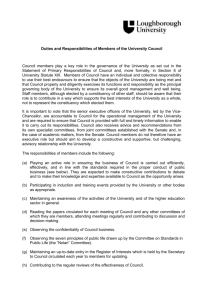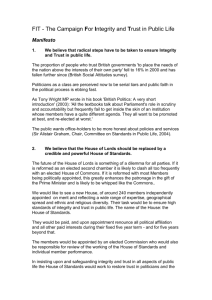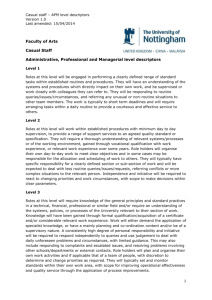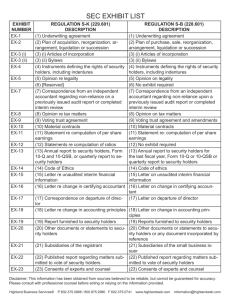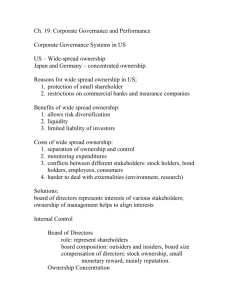The determination of the critical success factors (CSFs) in insuran
advertisement
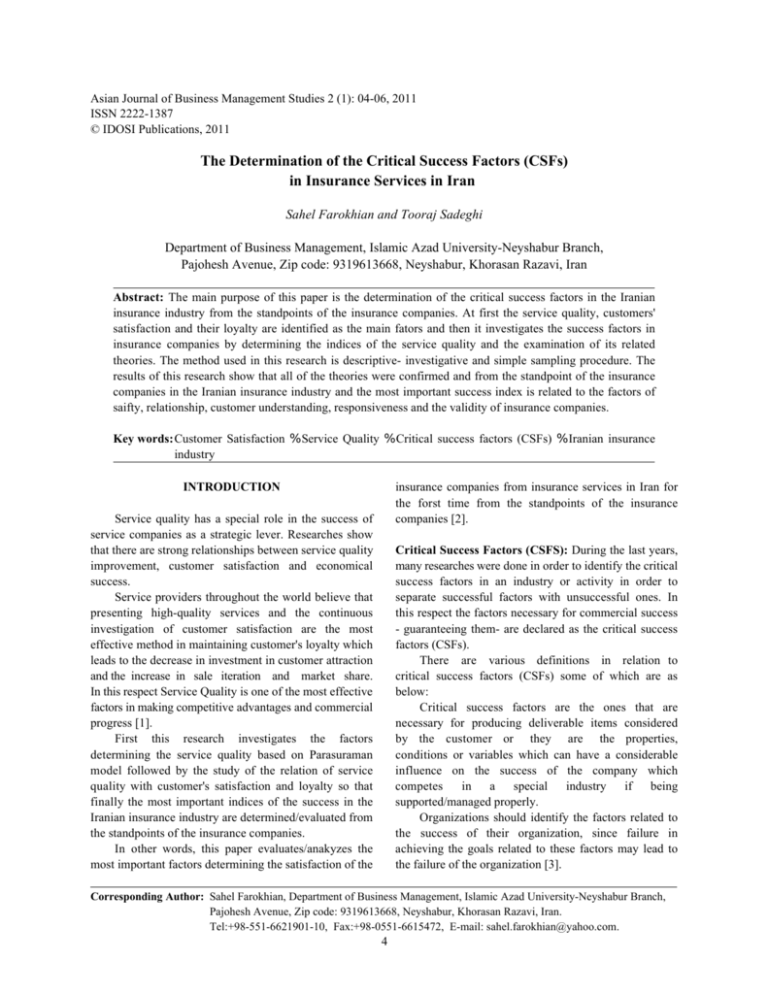
Asian Journal of Business Management Studies 2 (1): 04-06, 2011 ISSN 2222-1387 © IDOSI Publications, 2011 The Determination of the Critical Success Factors (CSFs) in Insurance Services in Iran Sahel Farokhian and Tooraj Sadeghi Department of Business Management, Islamic Azad University-Neyshabur Branch, Pajohesh Avenue, Zip code: 9319613668, Neyshabur, Khorasan Razavi, Iran Abstract: The main purpose of this paper is the determination of the critical success factors in the Iranian insurance industry from the standpoints of the insurance companies. At first the service quality, customers' satisfaction and their loyalty are identified as the main fators and then it investigates the success factors in insurance companies by determining the indices of the service quality and the examination of its related theories. The method used in this research is descriptive- investigative and simple sampling procedure. The results of this research show that all of the theories were confirmed and from the standpoint of the insurance companies in the Iranian insurance industry and the most important success index is related to the factors of saifty, relationship, customer understanding, responsiveness and the validity of insurance companies. Key words:Customer Satisfaction % Service Quality % Critical success factors (CSFs) % Iranian insurance industry INTRODUCTION insurance companies from insurance services in Iran for the forst time from the standpoints of the insurance companies [2]. Service quality has a special role in the success of service companies as a strategic lever. Researches show that there are strong relationships between service quality improvement, customer satisfaction and economical success. Service providers throughout the world believe that presenting high-quality services and the continuous investigation of customer satisfaction are the most effective method in maintaining customer's loyalty which leads to the decrease in investment in customer attraction and the increase in sale iteration and market share. In this respect Service Quality is one of the most effective factors in making competitive advantages and commercial progress [1]. First this research investigates the factors determining the service quality based on Parasuraman model followed by the study of the relation of service quality with customer's satisfaction and loyalty so that finally the most important indices of the success in the Iranian insurance industry are determined/evaluated from the standpoints of the insurance companies. In other words, this paper evaluates/anakyzes the most important factors determining the satisfaction of the Critical Success Factors (CSFS): During the last years, many researches were done in order to identify the critical success factors in an industry or activity in order to separate successful factors with unsuccessful ones. In this respect the factors necessary for commercial success - guaranteeing them- are declared as the critical success factors (CSFs). There are various definitions in relation to critical success factors (CSFs) some of which are as below: Critical success factors are the ones that are necessary for producing deliverable items considered by the customer or they are the properties, conditions or variables which can have a considerable influence on the success of the company which competes in a special industry if being supported/managed properly. Organizations should identify the factors related to the success of their organization, since failure in achieving the goals related to these factors may lead to the failure of the organization [3]. Corresponding Author: Sahel Farokhian, Department of Business Management, Islamic Azad University-Neyshabur Branch, Pajohesh Avenue, Zip code: 9319613668, Neyshabur, Khorasan Razavi, Iran. Tel:+98-551-6621901-10, Fax:+98-0551-6615472, E-mail: sahel.farokhian@yahoo.com. 4 Asian J. Business Manage. Studies 2 (1): 04-06, 2011 C Service Quality: Customers evaluate service quality by comparing what they exoect with what the service provider actually presents. Therefore qualiy may be defined as the difference between customer's expectations and their understanding of the actual performance of the company. In 1985 Parasuraman et al. classified more those 200 features of service quality. These features were obtained via interviewing with the customers of four different service departments i.e. banks, the organizations pressnting credit cards, service companies of repair and maintenance and phone communications center. They presented a standard for evaluating service quality according to 10 potential factors by using these 200 features which are: C C C C C C C C C Tangible factors: loans, appearance and the facilities of the provider such as staff's appearance and make up, equipments' modernity, etc. Reliability: the extent which makes the services believable such as the organizatin's fame and validity, staf's behavior, etc. Responsivness: the ability to reaching the complaints and improving the ssrvices in an effective manner Credibility: the ability of presenting services at the first time in a correct manner Competence: The ability of the staff to offer their information, knowledge and skills in presenting effective services Courtesy: Being respectful with friendly behavior against the customers Security: lack of risk and doubt Availability: the ease of access and making relationships with the organization in order to solve the customers' needs Communications: acknowledging the customers about how to present services such that they are understandable for the customers Underasting The Customers: the identification of customers' needs/wants, paying special attention to them and knowing loyal customers [4]. Research Methodology: This research is an applied descriptive study whose data gathering tools are interview and questionnaire whose questions are made based on standard questionnaire, quality measurement, design services and then making the necessary changes for making them native according to insurance experts' views. The measurement scale was concecutive using Likert spectrum. Table 2: Statistical indices related to insurers' views about success factors Average Number 0.046 0.045 0.043 0.035 Standard error Standard deviation 0.845 0.826 0.773 0.634 3.97 3.87 4.30 4.63 331 331 331 331 0.035 0.634 4.66 331 0.049 0.029 0.039 0.035 0.042 0.042 0.042 0.094 0.061 0.037 0.037 0.048 0.052 0.047 0.051 0.027 0.031 0.894 0.520 0.704 0.638 0.769 0.771 0.767 0.806 1.115 0.670 0.671 0.875 0.948 0.854 0.934 0.496 0.573 3.99 4.74 4.45 4.53 4.39 4.46 4.02 4.18 3.38 4.45 4.47 4.14 3.93 4.08 3.99 4.77 4.64 331 331 331 331 331 331 331 331 331 331 331 331 331 331 331 331 331 Location and physical situation (location, geographical situation, etc….) Designing the workplace for insurance activities Ease of policy holder's access to you as the insurer The amount of information and knowledge of the insurer in relation to different types of insurance The amount of your mastery in transferring properly the insurance information as the insurance representative The amount of your mastery on the strong/weak points of other insurance companies How to behave/treat the policy holders properly Rapid response to policy holders' complaints Following customers' demands and try to solve them Decreasing the waiting time of policy holders for receiving the services Try to pay the damage costs rapidly via following by the insurer The existence of proper physical infrastructures in order to respond to the customers Respond to customers' phone followings Using modern technologies such as internet, etc. Mutual cooperation with the policy holder Presenting insurance contracts related to policy holders' needs The competence of the declared rate in comparison with the oponents Try to present the researches to the policy holders Try to present various services to the policy holders Presenting insurance contracts with a high quality appearance and proper packaging Policy holders' trust and reliability to the insurer Your attempt to have a long-term communicate with policy holders 5 Asian J. Business Manage. Studies 2 (1): 04-06, 2011 C In order to determine the Reliability, Cronbach’s Alpha methid (the calculation of the internal coordination of questionnaire's questons) was used. 350 questions were distributed among the (governmental or private) insurers and the answers obtained were examined by using SPSS software. The value of the final alpha was 85% which shows the validity of the measurement tool. The Validity of the questionnaire was confirmed after being examined by the insurance experts. The statistical society of this research was the country of Iran including insurance representatives which were active as (governmental or private) insurers in 2010. According to the clearness of the list of insurers, random sampling was used. C C Findings and Results: According to the above-mentiond items, the results below are found: As you see, the insurers consider policy holders' trust/reliability as the most important factor in their success (with average 4.77). In addition, the least important factor is related to using new technology like internet (with average 3.38). The difference in indices classification in these four big cities such as respect/good behavior (in Mashhad and Tehran in the third rank, Isfahan in the fifth rank and Tabriz in the seventh rank) can be due to economical, cultural, social and traditional differences in these cities. Differences were observed in the classification of the factors, especially trust/reliability/validity factor between governmental and private insurance companies whose reason may be high trust of Iranian people to governmental companies which is too less to the private sector. Follow-up and responsiveness by phone were identified in policy holders' success, but using the internet for removing the need to physical reference has the least importance which shows the importance of the factor of lack of nedd to physically reference, but most of policy holders have problems worling with new technologied such as the internet. REFERENCES 1. Other Research Findings: it was discovered by the examinations performed in the classification of success preferences in four big cities of Mashhad, Isfahan, Tehran and Tabriz that three factors among others, i.e. customers' security, communications and understanding are more important which show the important neds of policy holders in this respect. In addition, the tangibility of services is identified the last success index in these four big cities whose reason may be not attending the policy holder's need on important level such as customer's understanding, responsiveness, security and access. 2. 3. 4. 6 Dargi, Parviz, successful sale and sale marketing, Iran Insurance Publications, First edition, 2003 Zaitamil, Valri. A. Parasuraman ""service quality, the investigation of Serokoal model and presenting new modes", Kambiz HeydarZadeh, Ali, Hajiha, Kasakavash Publications, 2010 Seddighiyan, Hossein, "marketing management and insurance sale", Iran Insurance Publications, First edition, 2004 Neyshabouri, Abolfazl, the investigation of the location and performing the management of customer's communications in Iran Melli Bank, Master thesis, Tarbiyat Modarress, 2010
